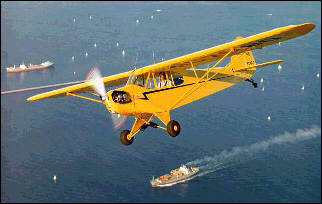
Beware the
"Safe" Airplane
Copyright 2007
by Richard Harris
Editorial, for In Flight USA, July 2007
(Additional material added for this online version)
NOTE: This editorial does not necessarily reflect the views of In Flight USA, its publisher, staff or management. Mr. Harris is a general aviation industry reporter, analyst and historian, who has done detailed historical studies of most major U.S. general aviation aircraft, flown several of the aircraft mentioned in this editorial, and worked for three major general aviation manufacturers in a wide variety of roles (though not employed by any of them presently).
For many years, ever since man has been flying, man has been crashing and dying. Consequently (and appropriately), man has been trying to build planes that are safer. In many cases, there has been success. But when safety is the key design issue, or the most conspicuous feature, the results are often, sadly and ironically, quite the opposite.
The 1929-1930 Guggenheim "safe airplane" contest yielded a crop of innovative prototypes -- including the winner, the Curtiss Tanager -- none of which ever attained any market success, as I recall. Shortly after winning the award, it crashed at an airshow in windy Wichita, Kansas. The last photo I saw of the Tanager showed it upside down, laying on its back following the crash. (It was rebuilt, then reportedly lost in a grass fire caused by its engine).
Conventional, obviously hazardous planes of the time were easier and cheaper to build and sell. And with the sudden arrival of the Great Depression, "cheap" became the buzzword in airplane design and manufacturing, as big-plane makers -- Stinson, Bellanca, WACO, Travel Air, Stearman, Curtiss-Wright, Ryan, Cessna, Beech (all famous for big, roomy planes) -- stumbled or faded from view (except through air racing, airliners or military planes). In their place, planes for the budget-conscious arose: Aeronca's C-2/C-3 "flying bathtub," Model K, and Chief; the Taylor/Piper Cub; the Curtiss Junior (resembling today's Challenger ultralight); the Heath Parasol kitplane; the Pietenpol homebuilt (powered by a Model A Ford engine); and so on. Exotic solutions for safety faded away to distant fantasy.
Piper J-3 Cub: First popular "safe" airplane.
Among these, in the 1930's, the Piper Cub was touted as a "safe" plane. It seemed to be one of the better planes in its class, considering the limitations of its class -- low-powered, compact, very light planes (so small and low-powered that today, many of them are legally classified as eligible for registration as Light Sport Aircraft -- along with some oversized ultralights and a few modern "microlight" planes, largely derived from glider technology). But as a class, these early personal puddle-jumpers were not an impressively safe group.

|
| The first popular light plane widely touted as "the world's safest plane": The loveable, delightful little Piper J-3 Cub. It can just barely kill you. But that's all it takes. |
The relative simplicity of these planes, and the Cub's particularly "gentle" manners (or so everyone claimed) -- complete with very low stall speed (38 mph -- 33 knots [originally reported incorrectly as "33 mph" ~RH]), and fairly simple and gentle handling characteristics -- earned it a reputation as the "world's safest plane" -- in its time. The wiser flight instructors countered that overworn sales slogan with the admonition that it was, indeed, "the world's safest airplane: it could just barely kill you."
Indeed, the Cub's contemporary record suggests a surprisingly troubling fatality rate for such a simple plane with such a low stall speed, and moderate airfoil design. Aviation Consumer magazine's Used Aircraft Guide, 9th ed., warns that the "the Cub's safety record is surprisingly poor by any standards" -- citing findings from a late-1970s NTSB study of single-engine light plane accidents, and a similar study focused on the previous decade. They noted the Cub had a fatal stall/spin crash rate of 3.46 deaths per 100,000 flight hours (not to mention other types of Cub crashes). Compare that to the plane that ultimately eliminated it as the world's main trainer: the Cessna 150, with fatal crashes of all types down around 1.35, per 100,000 hours.
The most commonly cited explanation is that the Cub's slow and gentle handling, good short-field/soft-field/rough-field capabilities, and its "fun airplane" character, tempts pilots to get low and slow -- and clown around low. Combine the Cub's feather-like wing-loading (lots of wing for a little bit of weight) with a low-altitude gust -- and control can suddenly be lost, in a place where there isn't time to recover. And the clowning-around down-low leaves the pilot extremely vulnerable to tragedy from a momentary failure of judgement in a steep turn, sudden pull-up, or climb, that -- aided by a trivial gust of turbulence, or momentary power loss -- instantly twists into an unrecoverable, low-altitude stall, and even spin. The Cub may wait for a lower speed to stall, but it WILL stall, and with an "attitude."
And the survival rate in these cases is not good.
In a fragile Cub, even an impact at 38 mph can be catastrophic. There's no "crush zone" in front of the front seat, except that provided by the worst possible padding: the main fuel tank, literally in the front-seater's lap. While the back-seater (most Cubs are soloed from the back seat, because of weight-and-balance issues) may have more crush-space ahead of him, falling planes often smack down onto the ground bottom-first, rather than nose-first -- and a severe belly-smack in a Cub holds special dangers. Rather than provide vertical crush-protection under the seat, the Cub's canvas sling (which passes for a rear seat), dangles its aviator over sharp metal parts -- waiting to impale him in a hard impact.
Cubs are awkward enough to exit in the best of conditions. In a crashed, mangled Cub, with your body banged up, and your innards skewered or your cockpit a flaming inferno, the situation is more difficult -- and good outcomes only hopeful.
Yet, today, generations after these facts have had time to be documented, studied, reported, and absorbed by the aviation public, the fantasy of the cute little Cub as a "safe little airplane" remains, given birth by optimistic promotion and casual assumptions -- and kept alive by deceptive legend, followed by wishful belief.
Yes, the Cub definitely can -- and may -- just barely kill you.

|
| The Stearman-Hammond Y-1, product of a 1934 challenge from the Bureau of Air Commerce boss to develop an "everyman's safe, low-cost, foolproof airplane" -- for $700. Based largely on the Weick/Wenziger W-1A, Dean Hammond's Y-1 (tweaked by Lloyd Stearman) surpassed biplane taildraggers of the era with tricycle gear, great visibility, low stall speed, and (to simplify flight) an automotive-style control wheel providing all turning control. A technical advance, it was a market failure, owing to expensive airplane engines and aluminum construction (when aluminum was relatively rare and costly) -- ultimately priced at $3,000, in the middle of the Great Depression. The Bureau became the main customer, buying 15 improved Y-125s for field use. (NASA) |
The "Airplane for the Everyman"
In 1935, the Bureau of Air Commerce (forerunner to the FAA) held a "safe airplane" contest (actually a contest to see who could come up with a good basic, cheap plane for the "everyman") which yielded a crop of innovative prototypes -- including the winner, the Stearman-Hammond Y-1. But none of the designs ever attained any market success.
The low-winged Y-1 imitated the Weick/Wenzinger W-1A, a plane designed for safety by a cadre of NACA engineers, with the idea of a mild-mannered, pusher-prop, tricycle airplane with great visibility. A slough of designs mimimcked the W-1A and Y-1 after the competition, including prototypes by Aeronca and Piper. But the idea never took off, and none of the designs was mass-produced. Years later, another variant, the Anderson-Greenwood AG-1, imitated it, as did a 1960's prototype by Cessna (The XMC -- "Experimental Magic Carpet"). All were abandoned before making it into major production. But every so often, someone revives the idea, briefly.
One key flaw, arguably, was the pusher engine. It's worth noting that pusher engines were one of the first aviation innovations to be shot down, as they participated in the demise of far too many early aviators who -- during an impact -- were squished between engine and earth, like a bug between hammer and anvil.
Yet, today, there are countless designs on the drawing boards, or in active experimental aircraft, and even a few (mostly short-lived) production planes, where the lessons of the pusher threat are ignored. But notice that the liability-wary old-time major manufacturers, wizend by countless lawsuits, don't go there anymore.
Ercoupe: "World's Safest Airplane," or the Exact Opposite?
In the 1940's, there was the "unspinnable" Ercoupe -- billed as "The World's Safest Plane," and stripped of such complicating features as rudder pedals. It was the brainchild of Fred Weick, who led the development of the W-1A. The W-1A's rear-mounted pusher engine was replaced with the more conventionally (and safely) forward-mounted tractor (puller) engine; the high wing became low; and the tube-and-fabric construction gave way to a hollow aluminum sheet-metal shell. The Ercoupe was THE pivotal pioneering aircraft for introduction of modern lightplane design -- tricycle gear and hollow-metal-shell (monocoque) construction. And it led to the design of a relatively safe plane (the PA-28 series Piper Cherokee).
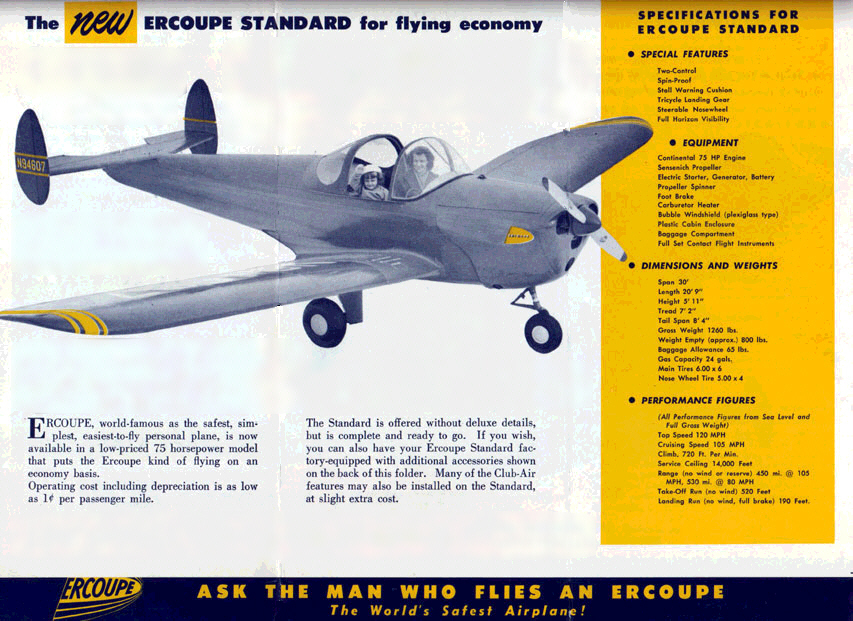
|
| The ERCO Ercoupe introduced tricycle landing gear and helped introduce modern, efficient, aluminum-shell aircraft construction to light planes. It also attacked stall/spin accidents by eliminating rudder pedals, limiting elevator travel, and various other means. With all these innovations, the manufacturer confidently declared the Ercoupe "The World's Safest Airplane!" (see the bottom line of this brochure) -- and just about everyone believed it. The record says otherwise -- in a big way. Perhaps the Ercoupe was safer than some of its contemporaries, but is no match for today's planes. Ercoupe designer Fred Weick went on to apply the Ercoupe's best features, and worst lessons, in helping Piper develop its much safer Cherokee. (Sanders Aviation) |
But the Ercoupe itself, heavily sold as "The World's Safest Airplane!", turns out to have one of the highest crash and fatality rates of modern light aircraft, per seat-mile flown. (In other words -- for every mile covered by an individual sitting in an Ercoupe, there is a much higher risk than in riding in most other such airplanes for the same distance.) Put simply, an Ercoupe is one of the most dangerous ways to get anywhere by air.
In a 1970s NTSB (National Transporation Safety Board) study -- of all major lines of general aviation airplanes then in wide use (over 30 basic designs) -- the Ercoupe scored poorly in most of the ten crash-type categories studied. And, in half of the categories, it was among the top three most-risky designs. It even scored badly in crashes listed under troubles it was supposedly immune from: stall/spin crashes (worse than Bonanzas and Mooneys) and groundlooping (worse than the Piper Cub)! (NOTE: While some faster aircraft had a higher rate of fatal accidents per 100,000 hours, they were mostly faster than the Ercoupe, transporting people farther for each hour traveled, getting people farther before an accident, resulting in a lower per-mile accident rate.)
Virtually no statistical evidence I've ever seen bears out the Ercoupe's billing as "the World's Safest Airplane" -- but the myth persists. If enough people say it loud enough, long enough, the data can be drowned out by desirable delusions.
Weick would later select the better aspects of the Ercoupe to incorporate in the 4-seat PA-28 series Piper Cherokee, while working with Piper on its design -- but left out many of the Ercoupe's "safety innovations" -- with the result that the Cherokee has a much safer record.
(And, in fairness, Weick also pioneered the modern cropduster, with its low wing, high, aftward cockpit, reinforced in a protective roll cage, and shielded from harm by a long nose, stout landing gear and wire cutters. That safety-oriented design concept, at least, appears to have worked -- reducing fatalities in cropdusting substantially.)
Wings: Where and How?
But what about the "unstallable" canard-wing clevernesses of Burt Rutan? They seem to have a troubling tendency to tumble from the sky. They gobble runway coming and going, somewhat block the pilot's view of his direction of travel, and have that awful pusher engine arrangement, which seems to be too-often fatal in otherwise minor or moderate accidents.
The Stinson 108 Voyager/StationWagon line has slots and limit-travel elevators (to help prevent stalls and spins). And a worse-than-average crash rate.
Gyrocopters, simple of control and design, and devoid of the troublesome complexity of helicopters -- and able to land vertically anywhere, even power-off -- were supposed to be a safer form of V/STOL aircraft, yet have apparently turned out to be the opposite.

|
| When the single-engine Piper Comanche evolved into the Twin Comanche, safety didn't exactly leap forward. Asymmetrical thrust and drag with an engine out -- particularly during training operations -- led to the light twin's all-too-common crash scenario. Piper made a significant dent in the problem by eliminating the "critical engine" (whose failure would most affect flight, by having the greatest adverse P-factor). This was achieved by making the props counter-rotate. The right engine is a mirror image of the left engine, and its propeller rotates in the opposite direction from the left one. This technique was so successful, Piper applied it to all its twins, and continued making light twins while its chief competitor, Cessna, quit -- citing crash lawsuits. (NASA) |
Twin Troubles
Twin engines, often touted as the solution to engine failure, by providing the safety of system redundancy, are not the answer, either.
Two engines (or more) were mandated on all early airliners by the late 1920s, and ever since, with apparently improved safety results. But on light planes, two engines don't provide the same boost to safety. In fact, in light twins, the result is quite the opposite.
Two small engines double your chance of getting into an engine-out situation, with asymmetric thrust and drag causing huge control challenges and nearly hopeless performance. Almost universally, general aviation light twins have a worse accident record than their single-engine counterparts of similar power, capacity and performance. Compare Bonanzas to Barons, Comanches to Twin Comanches, Cessna 210s to 310s.
Studies by the National Transportation Safety Board (in the late 1970s) and Aviation Consumer magazine in the mid-1980s, found that the most popular light-twin aircraft had higher accident rates, across-the-board than their same-brand single-engine counterparts (with retractable landing gear, and similar performance and capacity).
The numbers don't look good for the supposed "system redundancy" of two engines -- a fact echoed by the fact that many FBO's won't even let you fly their twins after you've earned a rating in them, until you've racked up dozens or hundreds of multiengine hours practice elsewhere. That's driven by their insurance policies, whose underwriters are all-too-familiar with the statistics.
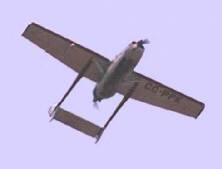 The Cessna 337 Skymaster (also shown below, with optional belly pod) tried to solve the light twin's typical engine-out handling problems -- caused by asymmetrical thrust and drag -- by switching to a tandem engine arrangement. Safety didn't improve as much as folks hoped. The aft engine is too-easily overlooked, and sometimes not even started, with accidents resulting. And the structurually complex design has special maintenance challenges. In fairness, its suitability for cargo and bush use invite more risky uses than most twins experience. (NASA)
The Cessna 337 Skymaster (also shown below, with optional belly pod) tried to solve the light twin's typical engine-out handling problems -- caused by asymmetrical thrust and drag -- by switching to a tandem engine arrangement. Safety didn't improve as much as folks hoped. The aft engine is too-easily overlooked, and sometimes not even started, with accidents resulting. And the structurually complex design has special maintenance challenges. In fairness, its suitability for cargo and bush use invite more risky uses than most twins experience. (NASA)
|

|
The "push-pull" Cessna Skymaster, with its twin engines mounted in tandem -- one tractor in the front and one pusher in the back -- was supposed to eliminate the deadly control hassles (and resulting wasted power) if one-engine failed. Yet its accident rate remained at the same level as other light twins in its payload/speed/power class -- particularly disconcerting since it was the only light twin built on the principles of Cessna's famously safe strut-winged singles.
Judging from reports, it seems that it's easy, with the Skymaster, to forget the engine behind you (out of sight, out of mind) and take off without starting it -- leading to the typical crashes resulting from grossly underpowered flight.
And then there's that hammer-and-anvil, pusher-engine thing.
The net result is that the aforementioned studies placed the Skymaster as the third-most-fatal light twin, with 2.5 fatalities per hundred-thousand hours of flight, clearly worse than the next-worse Cessna twin then in production, the conventional Cessna 310 at 2.1 (all other in-production Cessna twins ranked at 1.2 or lower).
In fairness, the Skymaster's rugged, high-wing virtues -- including the option of a big belly pod for additional cargo -- led to its use (and occassional abuse) as a cargo/bush plane and other hard-life, high-risk lifestyles, which few other light twins endure. And its position at the low end of the price spectrum for light twins may invite less affluent owners, less attentive to maintenance and training. But one wonders...
Aero Commander & Aerostar:
Ted Smith's Towering-Tail Twins
One of the more common-sense approaches for dealing with asymmetric thrust on twins has been to provide a bigger vertical tail, for better directional control when an engine fails. Nowhere has that solution been more conspicuously present, or absent, than in twins designed by Ted Smith -- Aero Commander (alias, Rockwell Commander, Gulfstream Commander, Twin Commander, etc.) and Aerostar.
Twin-engined Aero Commanders' towering vertical tails are so tall that many common general aviation hangars, which can hold Beech King Air 90 turboprops (and most other big twins), can't house even the smallest Twin Commanders, without special tricks or gimmicks. Ted's tall thin tails -- out on the end of long fuselages -- theoretically provide maximum leverage for a pilot in an engine-out situation, to overcome the twin's problems of asymmetric thrust and drag.
The FAA was reluctant to certify new light twins after World War II, and was particularly wary of their engine-out behavior. To convince the FAA that the Aero Commander was safe on a single engine, Smith removed the propeller from the prototype's "critical" engine, and stowed it in the baggage compartment -- then had the test pilot fly it (on the one working engine) directly from the Oklahoma City factory to a waiting FAA delegation in Washington, D.C. Apparently duly impressed, the FAA relented and certified the plane. The Air Force even used it as the first light plane officially assigned as "Air Force One" -- to fly President Eisenhower into the tiny airstrip at Camp David.
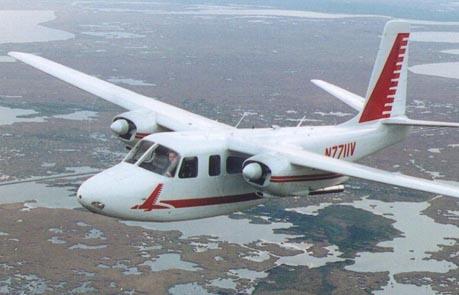
|
| Tall tails don't always run true. Though Aero Commander's legendary leverage in engine-out situations may work for you, that's not enough to keep them out of trouble. Big, heavy airplanes, with structural design characteristics well-suited for splendid pilot visiblility and near-acrobatic flight may actually make the crew and passengers more vulnerable to a fatal crash. |
The Aero Commander's legendary "single-engine cross-country" demonstration is commonly cited as proof that the plane is fine with an engine out. But that demonstration was made with the dead engine's prop stowed away inside the plane, rather than hanging out on the wing generating the drag that dead-engine props normally generate -- normally aggravating the thrust/drag asymmetry of twins with an engine out. Even so, most reviewers credit the Aero Commanders with fairly good directional control in an engine-out situation -- but...
But "overbuilt" Commanders are big and heavy, with hydraulically-driven (engine-power-dependent) systems (gear and flaps). They can be very adversely affected by engine-out situations, resulting in worse engine-out performance than others in their power class. Some may not be able to climb adequately when necessary, particularly under the heavy loads they're famous for being able to hoist with both engines.
Sitting low to the ground, there's not room for a lot of drop in a Commander, nor much obstacle clearance. Further, the peculiar high-wing, and center-placed engines, of Aero Commander twins -- famous among twins for providing unsurpassed pilot visibility -- are arguably a more vulnerable configuration in horizontal impacts. Most other twins' forward-placed propellers, engines and low wings will absorb some of the impact, before the cockpit and cabin collide with solid surfaces. But twin Commanders' relatively aft-placed props, engines, and wings (all above the cabin rather than below it) offer much less buffering between people and impacts -- or even pinch people between earth and airframe.
The Aviation Consumer study ranked the Aero Commander 500 almost as bad as the Skymaster -- tied with three other planes for fourth-worst of light twins -- at 2.1 fatal crashes per hundred-thousand hours aloft.
Aerostar - Special Challenges
Ted Smith left Aero Commander, to develop a smaller, sleeker, faster twin -- the Aerostar, which would be later paired briefly with Mooney, then ultimately with Piper, the most prolific developer of light twins. Built for speed, the Aerostar also retained the near-acrobatic flight capabilities of the twin Commanders.
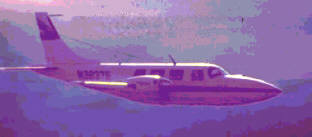
|
| Speed kills. Speedy airplanes kill -- especially in the hands of amateurs. Smith's aggressive Aerostar design makes an aggressive airplane -- one that can bite you quick and hard. Several major (and hazardous) quirks make it a real safety challenge -- for new pilots especially, but even for old pros who know its dark secrets. |
And the Aerostar retained the great pilot visibility of the Aero Commanders... and the associated adverse similarities to Commanders: during a crash, its wings, engines and props arrive at the point of impact, with or behind front-seaters (not ahead of them, absorbing impact, as in most other twins).
Compared to other twins in their power and payload class, speed is a special problem for the sleek Aerostars -- designed to be "the world's fastest piston-engined" light twins. Some Aerostars can run with turboprops. The secret is short, slender wings, on a sleek, narrow, compact fuselage (and even sleek engine nacelles).
Aerostar speed downsides?: Inflight accelerations greater than expected, especially in a dive, and too much vulnerability to turbulence (aggravated by a lack of wing diehdral -- upsweep). The Aerostar's thin wing (designed for speed) stalls rather abruptly -- too-often seizing control from a pilot while slowed down in the landing pattern -- too low to recover.
Unlike most planes of this speed -- which are typically flown by experienced, professional pilots, flying daily -- Aerostars tend to be owner-flown (Smith's apparently intended customer), with much less frequency, by pilots whose actual profession (and main skill and focus) is something other than flying. Yet these amateurs are flying a more demanding speedster than many of the professionals in similar-speed planes.
And, generally, the faster you go -- takeoff, climb, cruise, approach or landing -- the quicker you can get into trouble, and the less time you have to get out of it, and the worse the consequences on impact. In fact, impact forces rise by the square of the speed. Doubling your speed, quadruples your impact forces. (These generic speed problems, also, perhaps, explain troubles with the newest crop of sleek, "clean" all-composite, single-engine planes coming out today). Speed, itself, is a safety hazard.
Compared to other twins its size, the hot, peculiar Aerostar is rather unforgiving. Common pilot mistakes -- like failure to use flaps, running out of fuel, even a simple unlatched door (in front of the left engine and prop) -- are more likely to have much worse consequences in an Aerostar than is normal for other planes its size.
Speed, rarity, and a host of peculiarites result in Aerostars (and also the slower twin Commanders) presenting special safety challenges not normally encountered in their class. Relatively modest and common problems can quickly become very, very big (and tragic) things when encountered in Aerostars. And the stout, high-visibility, pilot-friendly design of the Aerostars and Aero Commanders may not be so helpful when engine failures and impacts do occur.
Not surprisingly, then, twin Commanders are really not the safety stars of their class -- and the Aerostar, it is generally reported, has just about the worst safety record of any popular piston twin, ever. At 3.8 fatal accidents per hundred-thousand hours, the Aerostar dwarfs the accident rate of any other light twin in production at the time of the study. In fact, the Aerostar might be summed up with the old saying: "Live fast, die young."
Overall, it seems, Ted Smith's tall-tail twins -- sold heavily on their "safety" virtues -- have reportedly, ironically, shown a much less safe record than other planes in their respective classes.
The Latest "Advances": Parachutes, Glass Cockpits, etc.
Today, we have the "safety" of airplanes with parachutes. Yet the Cirrus SR20/SR22 family apparently has a crash rate easily five times as bad as the Skylane RG -- an airplane quite comparable in cost, specifications and performance. The Cirrus, in fact, seems to be killing off pilots at a rate that would make critics of those "crash-prone" common single-engine retractables -- (fill in your favorite here) -- reluctant to ride a fixed-gear Cirrus.
Perhaps part of the Cirrus' problem is one of its safety innovations: the "big screen" all-in-one avionics/engine display, and (on newer models) the matching "primary flight display" which takes all the standard flight instrumentation and converts it to a video game. Supposedly, it's a leap foward in safety, this "integrated" approach to instrumentation display and controls. There are lots of theories about how this helps a pilot. But they seem largely to be centered on high-frequency professional pilots operating the same military or commercial or corporate jet, day-in and day-out, hundreds of hours a year, and getting regular, professional recurrent training and testing.
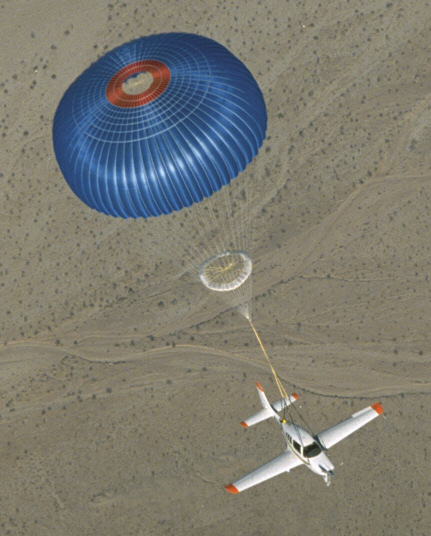
|
| This Cirrus parachute deployment test was successful. After establishing that the parachute worked properly, the pilot cut away the parachute, and restarted the gliding airplane and landed normally. (A parachute landing would have severely damaged the aircraft, even though the pilot would have survived). Not all Cirrus flights have ended this gracefully, however, and the parachute is pretty useless where most accidents begin: at pattern altitude or lower. (NASA) |
In fact, when the Cirrus was fairly new, I rode with a pilot who was also a senior air traffic controller, who couldn't take his eyes off the fascinating screen -- while boring (at 160 knots) through airspace he'd once controlled himself -- a corridor of airspace often populated by transponder-less gliders, ultralights, homebuilts and ragwing puddle jumpers, none of which would appear on his fancy "collision avoidance display" (CAS). He pointed at little dots on the display, noting how his CAS could identify "all" the airplanes around him. Only after I queried "Do you often find yourself thinking that?" did he realize the danger, and sat up straight and looked where he was going. And he was a CFI. How much less aware are the pilots of lesser qualifications, mesmerized by the complex video-game screens?
There is anecdotal, evidence, too, that airplanes with built-in parachutes are attracting pilots wanting to push the envelope, or tempting many -- after the sale -- to abandon their caution and tread where trouble lurks. But if that is the natural outcome of airframe parachutes, are they really a safety innovation?
Do "Bad" Pilots Happen to "Good" Planes?
The common defense of "safer" airplanes with less-safe records, is that safer airplane designs attract less-safe pilots: pilots with lower skill and proficiency levels, pilots with smaller pockets and less training, pilots who are older at the time of acquiring their license and first plane, pilots who know they are poor pilots and try to compensate with "safe" planes, and simply pilots who are so stupid they recklessly embrace every bit of marketing hype that comes along.
There is the argument, too, that pilots who think they have a safer airplane are going to be less cautious in their approach to flying.
These arguments seemingly all have some merit -- but what of the pilots of Cessna Skyhawks, who know they have the "safest single engine airplane" (to quote a couple of leading magazines)? The late-1970s NTSB study of single-engine light plane accidents, and a similar study focused on the previous decade. noted that the Cessna 172/Skyhawk, kept fatal crashes of all types down around 0.50 to 1.00, per 100,000 hours, the lowest of all 33 popular models evaluated (the rest of the low-risk ranking honors went to similarly configured Cessnas).
The now well-known safety record of the Skyhawk has not led to a reversal of it by reckless pilots.
The real problem is that -- since pilot error is the proximate obvious cause of most accidents -- the aviation community all-too-often ignores the subtle features of a plane that lead to, or exacerbate the consequences of, a crash.
We focus too much on the exotic solutions to safety, and ignore the down-to-earth solutions that prevent a pilot from prematurely coming down to earth, or protect him when he does:
"ASSUME?" You know what that does!
It is too-often, too-easily assumed that a plane built for safety (especially one with some odd characteristic billed as a "safety innovation") is safer -- when often it is really quite the opposite. Indeed, all of general aviation is hazardous, statistically -- industry hype and individual bluster notwithstanding. But the "safe" planes are often especially extreme examples of the unsafe.
An important exception would perhaps be the DC-3, designed from the start for safe operation, even with an engine-out on takeoff . And a few others are here and there. And generally, today, airliners are masterpieces of safety design, complemented by a safe regimen of careful maintenance, rigorous training and meticulous operation -- all prescribed and enforced by the heavy hand of modern regulators.
And there are some classic light planes which have the evidence of statistical backing to vouch for the safety of their design, despite their designs having been motivated more by considerations of production, performance and price. The simple, old-fashioned, "obsolete" strut-winged Cessna singles, for instance, though apparently designed with other purposes in mind, have turned out to be consistently among the very safest of light planes in virtually all studies.
But beware the temptation to ride a "safe" light airplane with cocky assurance. It may not be a safe flight, no matter how clever the designer's innovations.
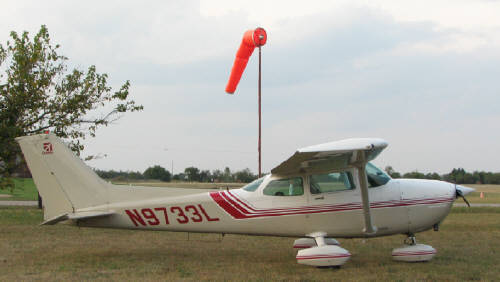
|
| Even the "safest" of light planes isn't as safe as an automobile. All light planes are utterly at the mercy of big skies, big planes, hard ground, and fallible human judgement -- in ways far more numerous and extreme than in any automobile. |
Light Planes, Heavy Risk
Remember, too, that even the safest light planes are utterly at the mercy of wind and weather, the turbulence and airspace congestion of other aircraft, the overwhelmed attentions of air traffic control (likely more focused on the needs of hundreds in a 747, than a handful in a light plane), and that greatest of aviation dangers: the general aviation pilot. Ultimately, no aviation safety innovation can completely compensate for that basic mechanical failure of the loose nut behind the wheel.
And remember that crashing a light plane isn't the same as crashing an airliner. The gust that smacks an airliner hard against the runway, with structural damage and minor injuries, can be the same gust that smashes a light plane agains the concrete like a plastic toy against a rock, scattering it (and its occupants) in pieces. And while airline disasters usually stimulate instant emergency responses, the lonely ignored lightplane crash -- far from any flight plan or supervised air route -- often turns the injured slowly into the deceased, as the minutes, hours, sometimes days, tick away, waiting for rescue.
All the slogans about aviation safety -- "safer than the drive to the airport," "some pilots are just bad, but not me," "flying by the book," "enough experience" -- are all ways of denying the basic truth that -- statistically -- general aviation flying ranks right down there with motorcycle riding (in terms of risk per seat-mile)... a fact amply demonstrated by the reality that it is among one of the tiny handful of activities (along with car racing, scuba diving, and acts of war) that life insurance companies (sticklers for good statistical research) normally exclude from coverage under most policies.
General aviation is a risk I love, but also recognize for what it is. I try not to lie to my friends and family, while inviting them aloft. I tell them the risks, and the rewards -- then respect and support their informed choices. I fly some risky flights, for fun or research -- but knowing that I'm conciously trading some of my life expectancy (or the risk of lifetime disability) for the chance to experience something few others ever enjoy. Yet I generally choose most of my flights with the desire to make that life expectancy, and that flying joy, both last as long as possible.
There IS a safe light plane. It's the one on the ground -- tied firmly to the earth, or locked in a hangar. All others are risks to be selected and managed with care.
~ RH
- END -